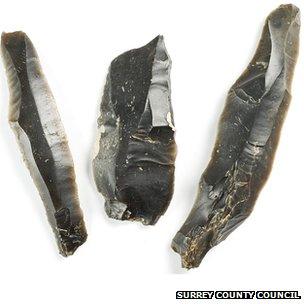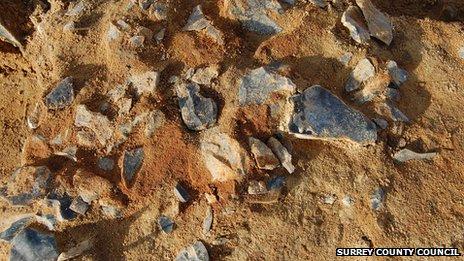Source - http://www.bbc.co.uk/news/uk-england-surrey-25720131

William Mills, from Oxford Archaeology, who worked on the dig, said the site was exceptional and one of two or three in England
A firefighter who found Stone Age flints at the fire station he worked at 40 years ago says he is "thrilled" that find has now led to a nationally-important archaeological discovery.
Ron Shettle, 88, first spotted the flints while working there decades ago.
A recent rebuild of the Guildford station has now allowed experts to carry out a dig.
Archaeologists have now found 2,400 flints - some dating back to the Ice Age - under the old fire station yard.
They say there are only a handful of such sites in Europe where a similar number of flints - many of which had been shaped into tools and blades - have been found.
Mr Shettle studied archaeology for a year at Dorking's evening institute while he was stationed in the town.
He wanted to study for a diploma but was transferred back to Guildford where he lived on the fire station site in houses for residential officers - and where he made a discovery that has now led to major interest.
'Dug deeper'

Mr Shettle said archaeologists dug a little deeper and found the Stone Age flint tools
He found Stone Age, or Mesolithic, flints at the site.
"Stone Age flints are recognisable, if you have seen them," he said.
"The average person wouldn't recognise them. I knew what I was looking at."
Those finds, about 40 years ago, were recorded in the local museum and with the Surrey Archaeological Society.
Mr Shettle said he went on to spent the next decades "prompting" local experts to carry out a dig at the site.
The opportunity came when Guildford fire station was pulled down to be rebuilt, he said.
Mr Shettle said: "They found Mesolithic flints, as I said, then they dug a little deeper, and found Paleolithic flints which go back to the Ice Age.
"That was something like about 16,000 years ago, which was when human beings on the site were changing from Neanderthals to present-day humans."
'National importance'
Mr Shettle added he was telephoned by archaeologists when they found the Paleolithic flints.
The county council "told me this was that they had come up with and it was of national importance".
"We are now waiting for Oxford Archaeology to come up with a report, which takes anything from six months to six years. They had better get a move on or I won't be around to see it, but obviously I was thrilled."

Experts said the flint tools were found exactly where hunter-gatherers left them
William Mills, from Oxford Archaeology, who worked on the dig, said the prehistoric flint tools, from about 14,000 years ago, were particularly interesting.
He said: "Most of the time you find it [the material] in caves, or in very disturbed environments, whereas here it's a very fine sand deposit, and therefore it's quite pristine - what we call in situ - it hasn't moved much."
He said research into the discovery would give more insight into the post-glacial period, the behaviour of humans and how they used to live, and the techniques and methods they used to produce tools.
"This is quite exceptional," he said. "In Europe, there are a handful of sites, not very many. In England, this is one amongst two, maybe three, if that."
Nick Truckle, from Surrey County Council's heritage conservation team, which recommended that the dig took place, said the remains from the end of the last ice age included more than 2,400 flints shaped into tools and blades, all in excellent condition.
He said the flints were found exactly where hunter-gatherers left them in about 12,000 BC, despite intervening centuries of river flooding and development.
The flints are to be sent for further academic research to Oxford University, and some may be displayed at the council's Surrey History Centre in Woking after the work has finished.